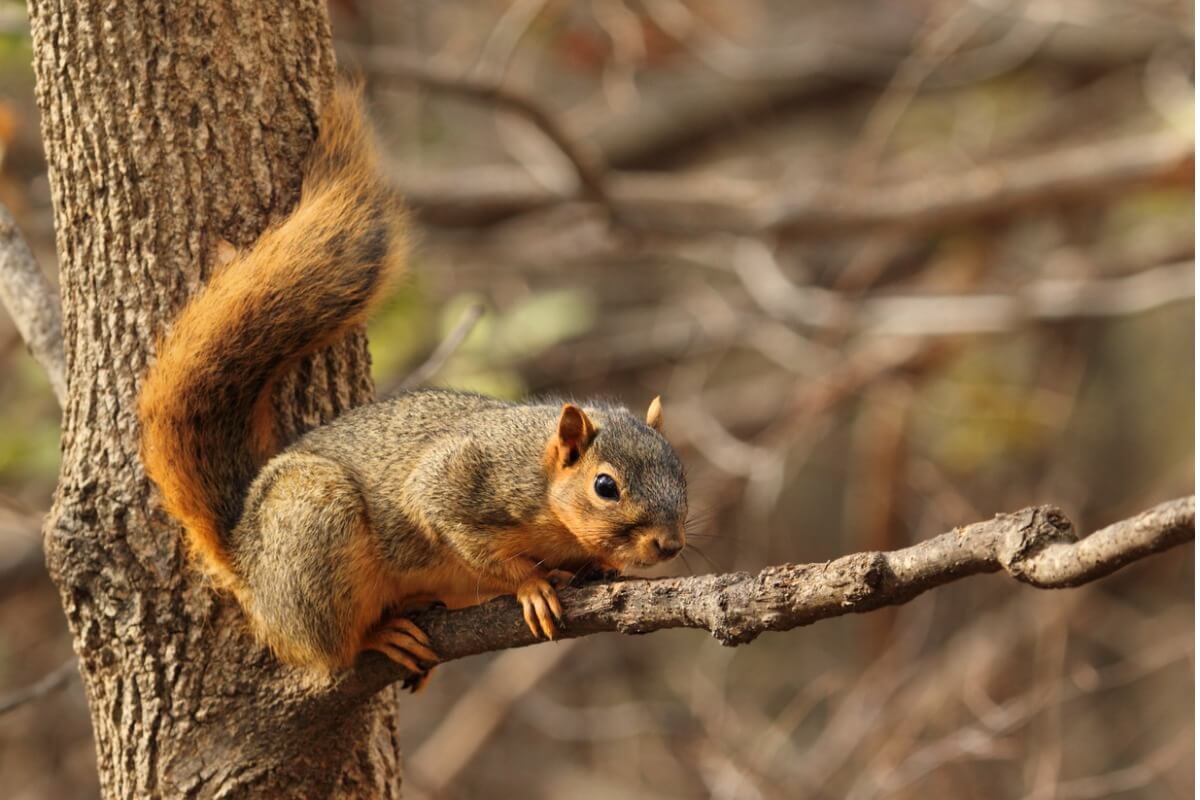Fox Squirrel: Habitat and Characteristics


Written and verified by the biologist Georgelin Espinoza Medina
The fox squirrel is considered the largest squirrel in North America and has a long, bushy tail and a variety of coat colors (orange, yellow, gold, and reddish), which make it a very colorful animal. It spends its days among the trees, although its ability and cunning don’t diminish at ground level, which is why it isn’t easy prey for its predators.
This rodent is commonly known as the eastern fox squirrel, and in the scientific community, it’s known as Sciurus niger. In addition, it’s divided into 10 subspecies that have color discrepancies, among other aspects. Read on to learn about all the characteristics and lifestyle of this amazing animal.
Habitat and distribution of the fox squirrel
The fox squirrel originally inhabited the entire eastern and central United States, which is why the word eastern is added to its popular name. It has now spread to the northern and southern prairies of Canada, as well as to some localities in Mexico. It has also been introduced into urban areas of the western U.S.
Its habitats include different types of forests, such as deciduous and mixed forests. In addition, these rodents prefer to colonize trees with fruit that they can store. The most popular are oak, hickory and pine trees. They use the holes in the trunks as shelters.

Physical characteristics of the fox squirrel
Sciurus niger has some resemblance to the gray squirrel, but can be easily differentiated by its larger size (this is the most important aspect of the species). It’s the largest squirrel in North America – with a minimum length of 45 centimeters (18 inches), while the longest recorded is 70 cm (28 inches), and an average of 60cm (24 inches). The tail adds 20 to 30 centimeters (8 to 12 inches) to its length.
The size of this squirrel also means it weighs quite a bit. Its minimum is 0.5 kilos (just over 1 lb) and its maximum weight is 1.3 kilograms (2.9 kilos). Its average weight is 0.8 kilograms (1.8 lbs). Females and males show no observable differences, so there’s no sexual dimorphism in the species.
The colorations of these squirrels are the most variable characteristics and each subspecies has its own shades. The shades of the fur vary between grey, yellow, golden, copper, and a reddish color. They also have a black tone in the dorsal area, while the ventral area is reddish.
In this species, we find the phenomenon of melanism, and it’s possible to find completely black fox squirrels. This aspect is more common in the specimens that live more towards the southeast, while albinism is unusual or very rare.
Behavior
This squirrel is arboreal and its life is spent among the trees, where it looks for food or takes refuge. It’s generally a solitary forager, except during mating periods when several males chase a female.
Fox squirrels don’t only move about in trees; they also run freely on the ground. In addition, there have been sightings of them swimming without any difficulty. Longevity in the wild is very varied (ranging from a few months to more than 10 years), but, in captivity, they can live to 18 years of age.
Period of activity
These rodents perform most of their activities during the course of the day. During this time, they forage for food, and they move from place to place and have a high dispersal capacity.
Successful hoarders
A particular habit of this type of animal is to store food supplies for the winter. They dig holes and bury nuts to a depth of about 2 centimeters – nearly an inch – or cover them with leaf litter.
This contributes to the germination of new trees, as it they can often forget where they left their food.
Communication
These squirrels communicate skilfully by means of moans, cries, clicks, and also use olfactory communication by means of urine marks. They usually emit characteristic sounds during mating.
Eastern fox squirrel diet
The diet of this rodent is composed of a large percentage of plant-based food. It can consume flowers and buds from the trees it lives in (American beech, longleaf pine, oak, holm oak, and walnut tree, among others).
This squirrel loves to eat the seeds of the nuts these trees produce, including walnuts.
To supplement their diet, these mammals may also catch some insects and also birds (and their eggs), although the proportion of animal consumption is much lower. The diet varies according to the availability of resources in each season. This rodent can be considered omnivorous because of its versatility when it comes to eating.
Reproduction
Squirrel reproduction is viviparous. The process doesn’t have a specific season or time, but can occur at any time of the year. The months with high reproductive rates are between November and February and April and July, with maximum peaks in December and June. Let’s have a look at some details regarding the courtship, copulation, gestation, and breeding behavior of these squirrels.
Courtship and copulation of the fox squirrel
When females go into heat, several males approach the female and chase her. They compete and establish a fight among themselves to obtain hierarchy and access to copulation. When confronted, the males adopt an upright posture with rapid movements of the tail. Another aspect to highlight is that this species is polygamous, that is, the females mate with different partners.
Gestation period and offspring
The gestation period of this specimen is no more than 45 days. An average of three individuals are born per litter, with maximum records of up to seven squirrels in a single birth. The babies are helpless, and they need their mother to feed them with her milk and this nutrition lasts up to 8 weeks. The male doesn’t participate in the care of the offspring.
The sexual maturity of these rodents arrives at 8 months of age for the females, while in the males it’s later and occurs between 8 and 11 months of age. Females usually have their first litter at about 1 year of age and, based on food availability, two births may occur annually.
Conservation status
The eastern fox squirrel has good numbers in the United States, so the classification assigned to it by the International Union for Conservation of Nature (IUCN) is a “stable population”. However, some subspecies have experienced habitat loss and extensive hunting, resulting in a decline in population.

In summary, the fox squirrel is the largest representative of its group in North America and has diverse color patterns depending on the subspecies. It’s a nimble rodent in the trees and an excellent swimmer with a very interesting lifestyle.
The fox squirrel is considered the largest squirrel in North America and has a long, bushy tail and a variety of coat colors (orange, yellow, gold, and reddish), which make it a very colorful animal. It spends its days among the trees, although its ability and cunning don’t diminish at ground level, which is why it isn’t easy prey for its predators.
This rodent is commonly known as the eastern fox squirrel, and in the scientific community, it’s known as Sciurus niger. In addition, it’s divided into 10 subspecies that have color discrepancies, among other aspects. Read on to learn about all the characteristics and lifestyle of this amazing animal.
Habitat and distribution of the fox squirrel
The fox squirrel originally inhabited the entire eastern and central United States, which is why the word eastern is added to its popular name. It has now spread to the northern and southern prairies of Canada, as well as to some localities in Mexico. It has also been introduced into urban areas of the western U.S.
Its habitats include different types of forests, such as deciduous and mixed forests. In addition, these rodents prefer to colonize trees with fruit that they can store. The most popular are oak, hickory and pine trees. They use the holes in the trunks as shelters.

Physical characteristics of the fox squirrel
Sciurus niger has some resemblance to the gray squirrel, but can be easily differentiated by its larger size (this is the most important aspect of the species). It’s the largest squirrel in North America – with a minimum length of 45 centimeters (18 inches), while the longest recorded is 70 cm (28 inches), and an average of 60cm (24 inches). The tail adds 20 to 30 centimeters (8 to 12 inches) to its length.
The size of this squirrel also means it weighs quite a bit. Its minimum is 0.5 kilos (just over 1 lb) and its maximum weight is 1.3 kilograms (2.9 kilos). Its average weight is 0.8 kilograms (1.8 lbs). Females and males show no observable differences, so there’s no sexual dimorphism in the species.
The colorations of these squirrels are the most variable characteristics and each subspecies has its own shades. The shades of the fur vary between grey, yellow, golden, copper, and a reddish color. They also have a black tone in the dorsal area, while the ventral area is reddish.
In this species, we find the phenomenon of melanism, and it’s possible to find completely black fox squirrels. This aspect is more common in the specimens that live more towards the southeast, while albinism is unusual or very rare.
Behavior
This squirrel is arboreal and its life is spent among the trees, where it looks for food or takes refuge. It’s generally a solitary forager, except during mating periods when several males chase a female.
Fox squirrels don’t only move about in trees; they also run freely on the ground. In addition, there have been sightings of them swimming without any difficulty. Longevity in the wild is very varied (ranging from a few months to more than 10 years), but, in captivity, they can live to 18 years of age.
Period of activity
These rodents perform most of their activities during the course of the day. During this time, they forage for food, and they move from place to place and have a high dispersal capacity.
Successful hoarders
A particular habit of this type of animal is to store food supplies for the winter. They dig holes and bury nuts to a depth of about 2 centimeters – nearly an inch – or cover them with leaf litter.
This contributes to the germination of new trees, as it they can often forget where they left their food.
Communication
These squirrels communicate skilfully by means of moans, cries, clicks, and also use olfactory communication by means of urine marks. They usually emit characteristic sounds during mating.
Eastern fox squirrel diet
The diet of this rodent is composed of a large percentage of plant-based food. It can consume flowers and buds from the trees it lives in (American beech, longleaf pine, oak, holm oak, and walnut tree, among others).
This squirrel loves to eat the seeds of the nuts these trees produce, including walnuts.
To supplement their diet, these mammals may also catch some insects and also birds (and their eggs), although the proportion of animal consumption is much lower. The diet varies according to the availability of resources in each season. This rodent can be considered omnivorous because of its versatility when it comes to eating.
Reproduction
Squirrel reproduction is viviparous. The process doesn’t have a specific season or time, but can occur at any time of the year. The months with high reproductive rates are between November and February and April and July, with maximum peaks in December and June. Let’s have a look at some details regarding the courtship, copulation, gestation, and breeding behavior of these squirrels.
Courtship and copulation of the fox squirrel
When females go into heat, several males approach the female and chase her. They compete and establish a fight among themselves to obtain hierarchy and access to copulation. When confronted, the males adopt an upright posture with rapid movements of the tail. Another aspect to highlight is that this species is polygamous, that is, the females mate with different partners.
Gestation period and offspring
The gestation period of this specimen is no more than 45 days. An average of three individuals are born per litter, with maximum records of up to seven squirrels in a single birth. The babies are helpless, and they need their mother to feed them with her milk and this nutrition lasts up to 8 weeks. The male doesn’t participate in the care of the offspring.
The sexual maturity of these rodents arrives at 8 months of age for the females, while in the males it’s later and occurs between 8 and 11 months of age. Females usually have their first litter at about 1 year of age and, based on food availability, two births may occur annually.
Conservation status
The eastern fox squirrel has good numbers in the United States, so the classification assigned to it by the International Union for Conservation of Nature (IUCN) is a “stable population”. However, some subspecies have experienced habitat loss and extensive hunting, resulting in a decline in population.

In summary, the fox squirrel is the largest representative of its group in North America and has diverse color patterns depending on the subspecies. It’s a nimble rodent in the trees and an excellent swimmer with a very interesting lifestyle.
All cited sources were thoroughly reviewed by our team to ensure their quality, reliability, currency, and validity. The bibliography of this article was considered reliable and of academic or scientific accuracy.
- Koproswki, J. (1994). Sciurus niger. Mammalian species, 479, 1-9.
- Linzey, A.V., Timm, R., Emmons, L. & Reid, F. 2016. Sciurus niger (errata version published in 2017). The IUCN Red List of Threatened Species 2016: e.T20016A115155257.
- Perkins, M. W., & Conner, L. M. (2004). Habitat Use of Fox Squirrels in Southwestern Georgia. The Journal of Wildlife Management, 68(3), 509–513. http://www.jstor.org/stable/3803383
- Sciurus niger, Animal Diversity Web (ADW). Recogido a 29 de octubre en: https://animaldiversity.org/accounts/Sciurus_niger/
- Trauth, S., & Jamieson, D. (1997). Swimming Behavior in the Fox Squirrel, Sciurus niger (Rodentia: Sciuridae), from
Northeastern Arkansas. Journal of the Arkansas Academy of Science, 51(38), 213-214. - Valdés, M. (2003). Las ardillas de México. Biodiversitas, 8(51), 1-7.
This text is provided for informational purposes only and does not replace consultation with a professional. If in doubt, consult your specialist.








